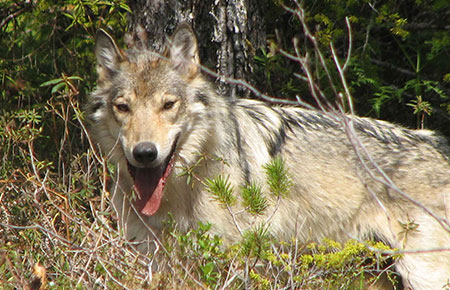
A two-month wolf-trapping season gets underway on Prince of Wales Island in mid-November. But this season brings changes from previous years — and not everyone’s on board.
The fact that the season will run for two full months is just one thing that’s different this year. State biologist Ross Dorendorf of the Alaska Department of Fish and Game explains.
“Previously, we had a quota based system, where we would create a quota for the number of wolves that could be harvested based on the previous year’s estimate for the wolf population,” Dorendorf said in a phone interview.
In other words, biologists would track how many wolves were killed as the season got going and shut it down once the target number was reached.
“And that proved to be difficult to manage,” Dorendorf said.
Dorendorf says it also wasn’t popular with people who hunt on the island because the length of the season was unpredictable.
The wolf’s pelt is a valuable commodity. Hunters and trappers often sell their catch to fur traders, who make them into coats and rugs.
Now the department is trying a new management strategy: limiting the length of the season instead of the number of wolves killed. In the new system, trappers can take an unlimited amount of wolves over a two-month period. Hunters can kill as many as five wolves.
The two-month season was set based on the estimated wolf population. Biologists set that by collecting hair from barbed-wire traps all over the island. Next year it could be different. A season can range from six weeks to four months. Or there could be no opening at all.
Prince of Wales Island’s wolf population is estimated at 170, which Dorendorf says is right where state regulators want it.
But conservationists who have long opposed hunting and trapping wolves are skeptical. Environmental groups have twice unsuccessfully petitioned regulators to list the island’s unique Alexander Archipelago Wolf as threatened or endangered under the Endangered Species Act.
“This is a terrible idea that puts these vulnerable wolves in greater danger,” said Shaye Wolf, a scientist with the Center for Biological Diversity, a wildlife advocacy group. The fact that trappers can take an unlimited number of wolves in the two-month season has her worried.
“Without a quota, the number of hunted wolves could get quite high and drive their population down to a dangerously low size,” she said.
But ADF&G’s Ross Dorendorf says the state is taking a science-based approach to game management.
“It was based on success from previous seasons,” he said. “Empirical information that we know had been harvested in the past and what kind of an estimate of the population we had after a season with harvest of X amount, and we just kind of scaled it up.”
The wolf trapping season opens November 15. The wolf hunting season opens on December 1. Both close on January 15.
You can read the full press release from ADF&G on the agency’s website.





